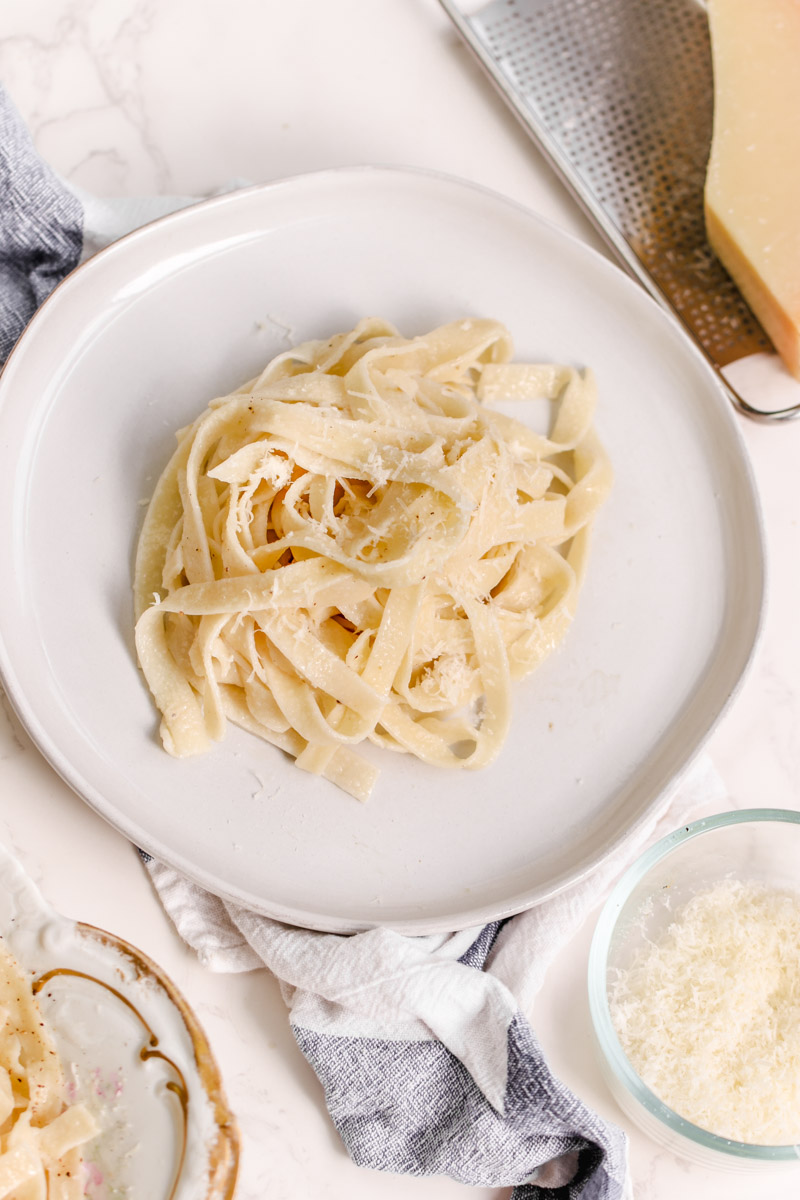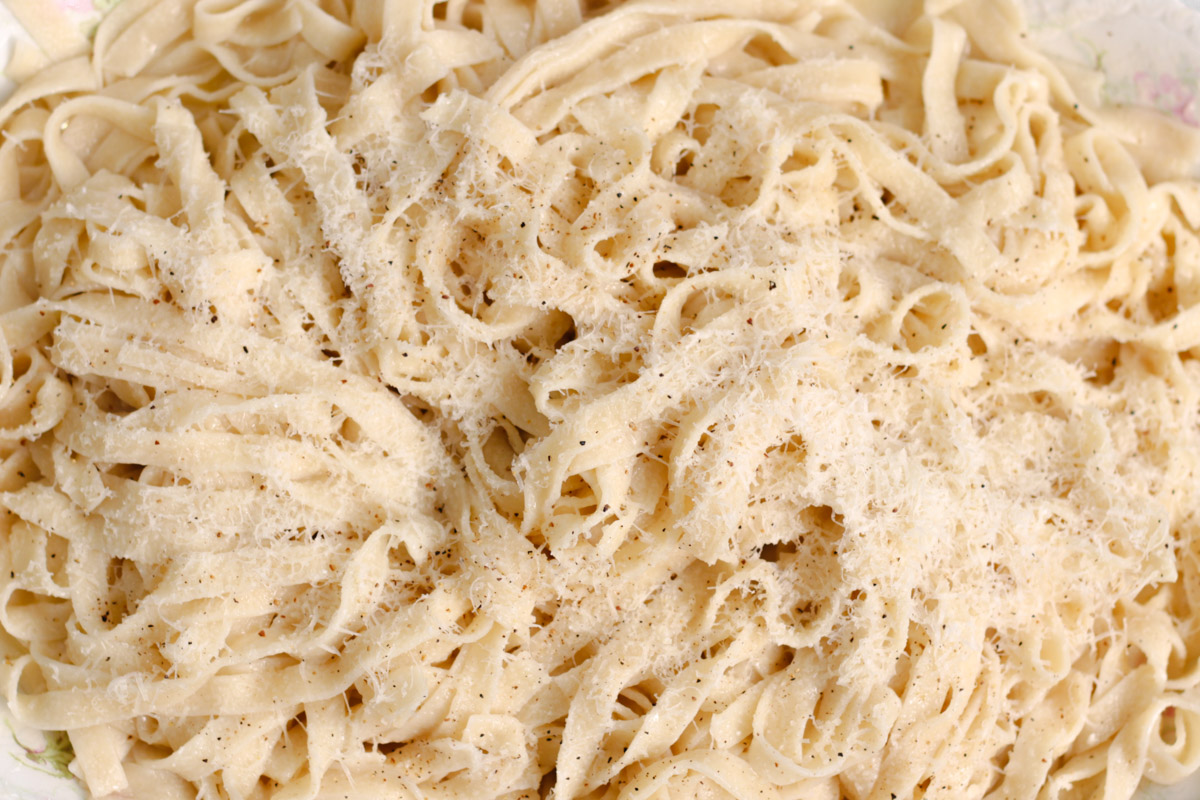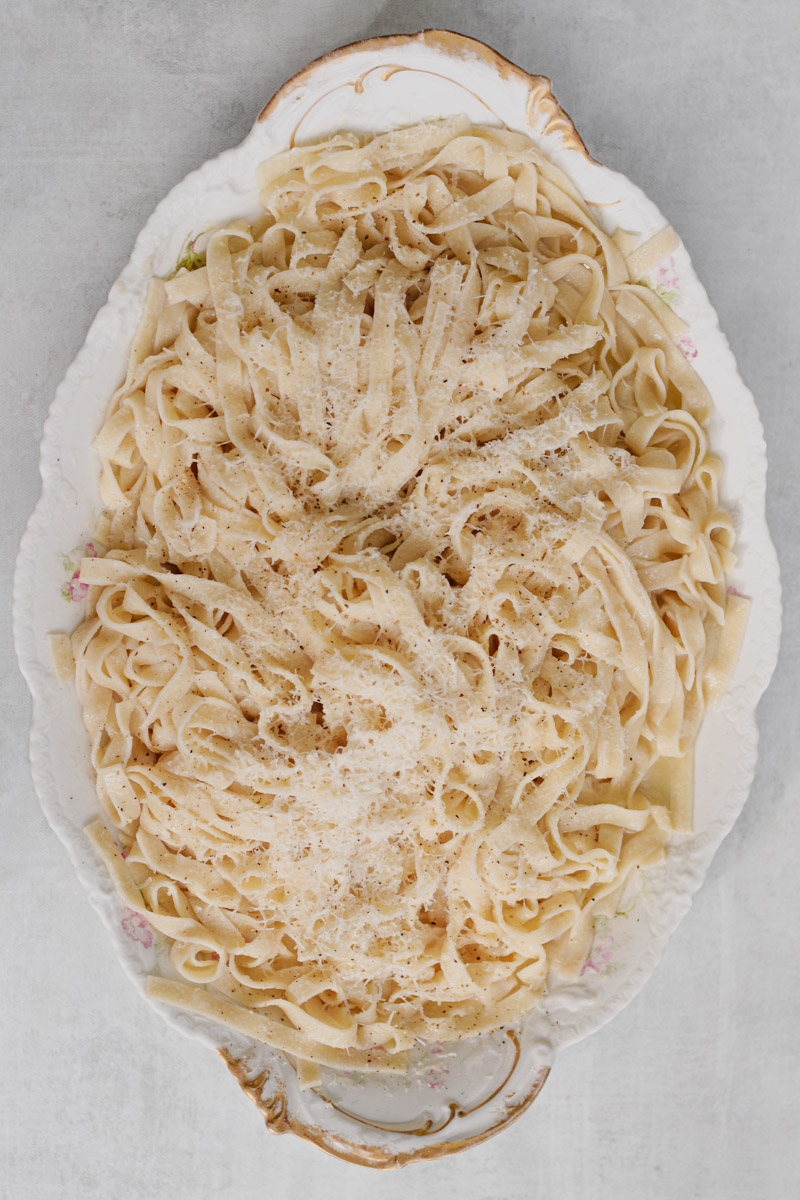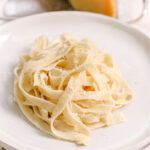This Traditional Fettuccine Alfredo (Without Cream) is made with fettuccine pasta, Parmigiano Reggiano cheese, butter, and a touch of freshly cracked black pepper. The creamy sauce is made with a quick technique and is ready in less than 15 minutes!

Why you'll love classic fettuccine Alfredo recipe:
- Quick and easy: This recipe takes less than 15 minutes to make, making it a perfect option for busy weeknights.
- Simple ingredients: Budget-friendly and really easy to prepare. It comes together with just four simple ingredients!
- Authentic Italian flavor: Made with authentic Italian ingredients like fettuccine pasta and Parmigiano cheese, this dish has a delicious and traditional taste.
- Perfect for any occasion: Whether you're cooking for a family dinner or hosting a dinner party, this dish is sure to impress guests with its creamy texture and rich flavors.
Jump To
- Why you'll love classic fettuccine Alfredo recipe:
- What ingredients are in fettuccine Alfredo without cream?
- How to make Italian Alfredo sauce?
- Expert tips to make authentic Alfredo sauce:
- Variations on the classic Alfredo sauce:
- Italian variations for pasta al burro e Parmigiano:
- How to cook pasta?
- What to serve with authentic Italian Fettuccine Alfredo recipe?
- How to store authentic Italian fettuccine Alfredo recipe?
- How to reheat fettuccine Alfredo?
- How to store grated Parmgiano Reggiano Cheese?
- FAQ's
- Some other pasta recipes to enjoy:
- Fettuccine Alfredo
When I think of Italian pasta recipes from my childhood, this is one of my absolute favorites: pasta al burro e Parmigiano or fettuccine al burro. To clarify: this is an Italian recipe, but in Italy it is NOT called fettuccine Alfredo. Unless you are in Rome, there is the original restaurant where it was created and a handful of others that call it Alfredo.
"Alfredo sauce" as a sauce, does not exist in Italy. In Italy, you may also hear it called "spaghetti cremosi burro e Parmigiano", which literally means creamy spaghetti with butter and Parmigiano. But as you travel around Italy and check out restaurants, you will not get much luck if you request an "alfredo sauce" or any sort of "pasta Alfredo.
We'll get to the history of fettuccine Alfredo, but for now, I'll let you know that this is a very simple dish with a handful of ingredients. It's the quality of the ingredients and the steps that will make sure you get the creamiest cheese sauce (without any cream!). Let's get onto the recipe for a "vero Alfredo"!

What ingredients are in fettuccine Alfredo without cream?
I will emphasize as I do with many pasta recipes, it's the quality of the ingredients that will make sure this sauce turns out so flavorful! DO NOT skimp on the quality of the cheesen (and the butter!)!
Full printable recipe is below.
- Freshly grated cheese- Parmigiano-Reggiano cheese, not canned parmesan cheese. If you use parmesan cheese, the sauce will not be the same as an authentic Alfredo. Italian chefs will recommend a Parmgiano-Reggiano that is at least 24 months old.
- Butter- Unsalted butter. The better the quality of butter, the better the flavor of the sauce. It will be cut into cubes and it's better if it's room temperature (not melted). Make sure it's not cold, right out of the fridge.
- Pasta – you can use fresh fettuccine pasta, dry pasta, spaghetti, linguine, or homemade pasta.
- Freshly ground black pepper: Using some freshly ground black pepper is totally optional. I like a touch of black pepper. Leave it out, if you don't like the flavor.
- Sea salt – for cooking the pasta.
- Starchy pasta water-Scooping out carefully some of the starchy pasta water while the pasta cooks is important to make the sauce creamy (without the addition of any actual heavy cream).

How to make Italian Alfredo sauce?
First thing to do is gather up all your ingredients. There are only a handful, so have them ready!
Grate your Parmigiano (unless you buy already grated Parmigiano Reggiano). Cut the butter into 6 portions.

Step 1: Add half the butter chunks onto a serving platter or a large pasta bowl. The butter should be room temperature (not melted)and not frozen.
Step 2: Boil the pasta in salted water. Make sure you use a large enough pot to be able to stir the pasta and not have it overflow. The pasta expands as it cooks.
Step 3: Use a ladle to scoop out 1 cup of the boiling hot starchy pasta water.

Step 4: Add 1/2 cup of starchy boiling hot pasta water to the butter and stir to melt it on the platter.

Step 5: Combine the butter with the hot water (use tongs or a spoon to stir and melt it together).
Step 6: Strain pasta and add to the platter with rest of butter chunks and the other 1/2 cup of hot starchy pasta water. Stir to combine using tongs.
Step 7: Add the other 3 butter portions and use tongs to combine with the pasta.
Step 8: Add the rest of the starchy hot pasta water and combine with the pasta.
Step 9: Add the Parmigiano and use tongs to combine it all together with the butter sauce.

Step 10: If you like black pepper, crack some on top and add some more Parmigiano cheese. Serve and Buon Appetito!
Expert tips to make authentic Alfredo sauce:
- Use a large enough pot to cook the pasta. It needs room to boil and cook evenly.
- Salt the pasta water as you are not adding salt to this sauce.
- Cook the pasta until al dente. If you over cook the pasta, you'll have a MUSHY pasta Alfredo. I'm not sure about you, but I do NOT like mushy pasta. It needs to be al dente (cooked "to the tooth").
- If you are gluten-free, you could make this using your favorite gluten-free pasta brand.
- Most important tip is to not use canned "Parmesan cheese" for this sauce. The only way to make this sauce is with authentic Parmigiano-Reggiano cheese. You could grate your own or buy it already grated, but it has to be Parimgiano cheese. Parmesan will result in a clumpy mess.
- The secret to not use any heavy cream and getting a really creamy Alfredo sauce is to reserve some of the boiling hot starchy pasta water. The starchy water will bind the butter and cheese with the pasta when it's combined and make the creamy sauce.
- The other secret to getting a creamy Alfredo sauce without any cream added in is the METHOD to make the sauce. You have to be sure to use butter that is not melted and NOT frozen. Butter needs to be room temperature.
- Another secret (HOT TIP)is to combine it with kitchen tongs and make sure the pasta water is starchy and boiling hot! Do not ladle out the pasta water as soon as you the pasta water in it to boil.
- The starch from the boiling pasta is what will help to create the creamy sauce combined with soft butter and the final step, adding in the cooked pasta and the grated Parmigiano.

Variations on the classic Alfredo sauce:
To keep it authentic, just follow my recipe and do not make any variations. But if you find yourself in the States, you will come across different variations. Here are some variations:
- Chicken Alfredo pasta is pretty popular in the States. If you want to make that, cook up some chicken breasts, slice it up, and add it to the pasta (to emphasize: you will most likely NEVER find a "chicken Alfredo" in Italy and should not ever ask for that at a restaurant.
- Shrimp Alfredo pasta is another popular dish in the States. Same thing like the chicken, you could cook up the shrimp and add it to the sauce.
- Toss in some grilled vegetables to the pasta before adding the cheese.
- If you want to flavor it up, add in some minced garlic and red pepper flakes to the butter before mixing with the pasta.
- If you don't have fettuccine on hand, you could make this sauce with other long pasta shapes like linguine or spaghetti.
Italian variations for pasta al burro e Parmigiano:
If you want to make a pasta Alfredo with an Italian variation, here are some ideas:
- Truffles: If you could get your hands on a white or black truffles, a little bit grated on top would be absolutely divine!
- Lemon: A little bit of organic lemon zest on top would add a touch of freshness to this creamy sauce.
- Nutmeg: A dash of freshly grated nutmeg adds a lovely flavor addition to this cheese sauce.

How to cook pasta?
It's important to buy a good quality pasta, or make your own fettuccine. Follow the cooking time on the pasta box and be sure to set a timer to cook it to al dente.
First step is to use 4 cups (1 liter) of water for every 3.5 ounces (100 grams) of pasta. Make sure it's a large enough pot and that the pasta has enough room to expand as it cooks up.
Second step is to correctly salt the water. It should be 1 teaspoon (5 grams) of salt to ever liter (quart) of water. Add in the salt as soon the water comes to a rolling boil.
What to serve with authentic Italian Fettuccine Alfredo recipe?
This Italian pasta recipe is satisfying on its own. But it would go nicely with a big salad or do it the Italian way and serve it as a "primo", first course. For the "secondo", second course, you could serve a lemon chicken or a steak.
How to store authentic Italian fettuccine Alfredo recipe?
There may not be any leftovers, because this pasta is so delicious! But if there are, here is what you can do.
- To refrigerate: Once cooled, store in air-tight container for 3-5 days in the refrigerator. Reheat on the stove on medium heat. To loosen the sauce, you could add a bit of water and add some extra freshly grated Parmigiano-Reggiano cheese.
- To freeze: I do not recommend freezing this pasta recipe.
How to reheat fettuccine Alfredo?
If you happen to have any leftovers (I will be surprised if you do!), it's easy to reheat:
Add the leftovers to a sauce pan on medium heat. Add a bit of water to the pan and stir it a little to combine and loosen up the sauce. Once it's heated through, you could serve with some more grated Parmigiano cheese.

How to store grated Parmgiano Reggiano Cheese?
Once you grate up some Parmigiano, it will stay fresh in an airtight container for up to two weeks. You could also freeze it for up to 18 months. Grated cheese could be stored in Stasher Reusable Silicone Storage Bag. These bags are really great for storing grated cheese of any kind and can be used to store other things.

FAQ's
Fettuccine Alfredo has its origins in Rome, where it was crafted by the renowned restaurant owner, Alfredo di Lelio. The inspiration behind this delightful dish came from Alfredo's pregnant wife, Ines, who was craving a pasta dish that would provide comfort and energy during her pregnancy. Alfredo masterfully concocted a rich and simple recipe to fulfill his wife's cravings. What's amazing is that to this day, the legacy of Alfredo's easy yet extraordinary creation lives on!
Yes, fettuccine Alfredo was created in Rome, Italy by Alfredo di Lelio.
During their honeymoon in 1927, Mary Pickford and Douglas Fairbanks dined at Alfredo di Lelio’s restaurant in Rome, Italy. Way before the powers of social media were created, they were so enamored with his 'Fettuccine Alfredo Recipe' that upon their return to the United States, they couldn't help but spread the word about this exquisite Italian pasta dish. Fast forward to 1966, when the Pennsylvania Dutch Noodle Company introduced their own variation of the dish, advertising it as "Fettuccine Egg Noodles."
To clear up any confusion, if you come across something labled "Parmesan", it not an authentic Parmigiano Reggiano from Italy. Parmigiano Reggiano cheese has the Italian DOP (Denominazione di Origine Protetta, which means Protected Designation of Origin). This lets a consumer know it is guaranteed to be made in Italy with a special aging process.
The creamy sauce in Fettuccine Alfredo without cream comes from mixing the finely grated Parmigiano cheese with the butter, reserved pasta water, and hot pasta. The creamy sauce will form by incorporating the ingredients in the way this recipe details
Fettuccine Alfredo is a very simple Italian pasta recipe made with butter, Parmigiano-Reggiano cheese, pasta (typically, fettucine), and is a simple Italian dish of butter, parmigiano, fettuccine pasta, and black pepper. The authentic recipe does not use heavy cream. I think of it as a glorified butter and cheese pasta with a triple dose of butter.
Any freshly ground Parmigiano cheese could be stored in a zipped lock plastic bag or an airtight container in the refrigerator for up to two weeks. Seal the bag tightly (squeezing out any air while you seal it), date it, and you could keep it in the freezer for up to 18 months. Or, simply store in a freezer safe airtight container.
Did you make this? Please RATE THE RECIPE below:)
Please Subscribe and give a follow on Instagram, Facebook, Pinterest, and TikTok xx
Some other pasta recipes to enjoy:
- Vegan Pumpkin Pasta with Sage
- Pasta with Ricotta and Peas
- Ziti al Forno-Baked Ziti with Meat Sauce
- Fettuccine with Weeknight Lamb Ragù
Fettuccine Alfredo
Equipment
Ingredients
- 1 lb Fettuccine pasta
- 1 ½ cups fresh finely grated Parmigiano Reggiano cheese divided, more for serving
- ½ cup unsalted butter divided, at room temperature (use a very good grass-fed better for the best flavor)
- Freshly ground black pepper to taste optional
- salt for the pasta water
Instructions
- Bring a large pot of water to a boil and salt it. Cook the fettuccine until it's al dente (check timing on the pasta bag or box and set a timer).
- Cut the butter into 6 portions.
- While the pasta cooks, add half of the butter in large chunks to a serving platter. Be sure the butter is not frozen, as you want the butter to be soft as it's waiting to be combined with the pasta and cheese.
- Before straining the pasta, reserve 1 cup of the hot starchy pasta water. You could carefully ladle it out into a measuring cup.
- Add 1/2 cup (about 3-5 tablespoons) of the hot pasta water to the platter with the butter and stir until the butter melts.
- As soon as the pasta as al dente, strain the pasta and add it to the platter with the melted butter and pasta water and use tongs to combine it all together.
- Add the other 3 portions of butter to the pasta and the other 1/2 cup of the hot pasta water. Use the tongs to combine it, stirring, until all the butter melts and the pasta is coated with the butter sauce.
- Add the Parmigiano and use tongs to combine it all together with the butter sauce.
- Serve immediately with some more freshly grated Parmigiano and a few crack of some freshly ground black pepper (optional). Enjoy!
Nutrition Disclaimer
Please keep in mind that the nutritional information presented below is an approximation and may vary depending on the exact ingredients used.
Notes
- Pasta: I used store-bought fettuccine. I used a very good Italian brand. Use your favorite brand or any long pasta.
- Cheese: DO NOT use canned Parmesan cheese, as it won't melt properly with the sauce. Use a Parmigiano Reggiano cheese. It's worth it to splurge and get a better brand. Also, do not add the cheese onto the butter. It gets added on after the butter and pasta water is melted.
- Butter: A very good grass fed butter is best for this sauce.
- Black pepper: Adding freshly ground black pepper is optional. You could crack some on top as soon as it's ready to serve.
- Best eaten: I highly recommend eating this as SOON as it's all combined with the sauce. Otherwise, the longer it sits, it starts to get sticky.




Jules says
This is so easy to make! No CREAM! It wasn't heavy and I added a little extra black pepper. Delicious!! Happy New Year to all of you!